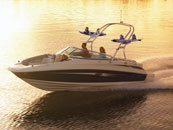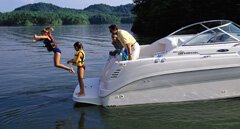How do you get back in when a potent wind and opposing tide put breakers at the mouth of the inlet? One answer: slowly.
By Capt. Stuart Reininger
Early March is when I bring a client’s boat from Jacksonville, Florida, down to Miami. At that time, the Atlantic coast is beset by cold fronts that bring with them strong winds and rough seas. I typically wait for the first two or three days of a front to pass through and then set off as the weather eases. Because there’s still a northerly component present, I can take advantage of following seas to ease my way south — a fuel-saving and comfortable way to travel. Usually, as the cold front passes, the weather will rotate around to its prevailing southeasterly flow.
On a recent run aboard that boat, I was counting on pulling into Miami with the final breaths of that gentle northerly on my heels. But as any skipper knows, weather predictions are, all too often, just predictions.
I was a few miles north of Fort Pierce Inlet when the seas began rising and the wind picked up. Another norther had piggybacked onto the weakening one. On the radio, there were reports of 8- to 10-foot seas and 30 knots out of the northeast. I wasn’t too concerned, as I knew I could tuck into the Fort Pierce Inlet, which is well-buoyed and easy to enter under most conditions. But by the time I got to the sea buoy, there were breakers across the mouth.
Going out to that sea buoy was my first wise move. In fact, I always do this when running an inlet, regardless of the conditions. From the sea buoy, I was able to observe the inlet from a safe distance, check out traffic and plan an approach.
I also examined the tidal predictions. The inlet was still ebbing with another two hours to slack. An ebbing tide against a strong onshore wind will always produce turbulent conditions. For that reason, I decided to stay offshore until the change of tide. I did this by turning into the seas and utilizing just enough power to hold a comfortable position. With most boats, this "hove-to" stance can be accomplished by taking the seas a few degrees off the stem and not bowing directly into them, which can cause pounding.
The breakers subsided when the tide changed, but wind-driven seas were still rolling into the inlet. The run in from the sea buoy allowed me plenty of time to position the boat to be in synch with the seas. I brought it in at a rate slower than that of the following seas. When a boat gets in trouble entering an inlet, excess speed is almost always a factor, especially when the vessel overtakes a following sea. Also, it’s rare for seas to march squarely into an inlet. They usually roll in at some angle that needs to be compensated for. When the approach is made slowly and from a safe distance out, you’ll make that compensation almost automatically.
A few hundred yards from the jetties, a center console with two people aboard was running fast off the beach. It passed in front of us, then turned sharply into the inlet. As it made the turn, it rode up on the back of a sea and was carried in and eventually slammed into the jetty. In the few seconds the boat hung there, its crew scrambled onto the rocks. The boat then washed back off, inverted. It was an unfortunate incident, and a direct result of running too fast and losing control in a sharp turn.
Proper planning requires taking a close look at the chart and applicable publications of any inlet along your course that you might have to enter in a pinch. I look for chart notes stating entrance buoys are regularly repositioned, since this is an indication of shoaling. Also, shallow water is a relative thing. If your boat draws 4 feet and the chart shows 10, that’s not necessarily a free pass. Shallow areas surrounded by deeper water are notoriously prone to breakers when the wind picks up — the southern approach to Maryland’s Ocean City Inlet is a poster child for that situation.
If an inlet has doglegs in its approach channel — think North Carolina’s Beaufort — the reason is usually shoal areas snaking toward the channel. Such shoals have a nasty habit of spreading into the channel before somebody gets around to repositioning the buoys. Therefore, it’s a good idea to favor the side of the channel away from the shoal when you’re making an approach.
I know of a few inlets that require you to make a sharp turn immediately after entering in order to stay in the channel — New Jersey’s Barnegat comes to mind. As a rule, these switchbacks are well-buoyed. However, that turn wouldn’t be there if danger wasn’t adjacent. Considering the cutbacks in water-way maintenance, I would rely on the depth sounder and my own eyes, rather than an outdated chart, to determine where deep water is when negotiating a turn.
Yes, it can get challenging off-shore, but you’ll be safer off the beach than on it. So if an inlet looks unapproachable from your position offshore, it probably is. Hang out and wait for conditions to improve or go elsewhere.
Shared with permission by MotorBoating.


